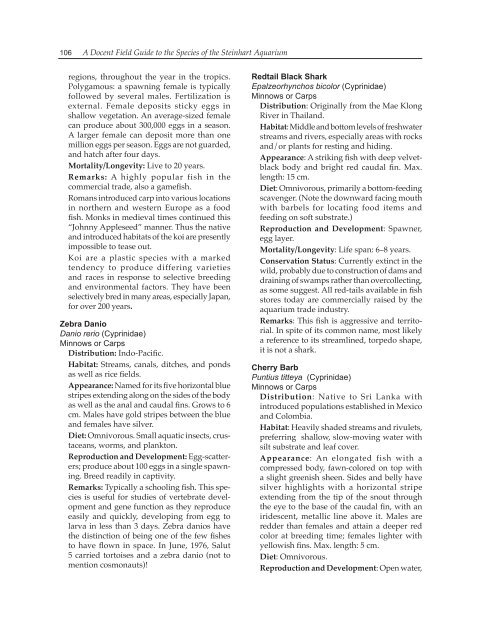THE STEINHART AQUARIUM - Gulf of Guinea Science ...
THE STEINHART AQUARIUM - Gulf of Guinea Science ...
THE STEINHART AQUARIUM - Gulf of Guinea Science ...
You also want an ePaper? Increase the reach of your titles
YUMPU automatically turns print PDFs into web optimized ePapers that Google loves.
106 A Docent Field Guide to the Species <strong>of</strong> the Steinhart Aquarium<br />
regions, throughout the year in the tropics.<br />
Polygamous: a spawning female is typically<br />
followed by several males. Fertilization is<br />
external. Female deposits sticky eggs in<br />
shallow vegetation. An average-sized female<br />
can produce about 300,000 eggs in a season.<br />
A larger female can deposit more than one<br />
million eggs per season. Eggs are not guarded,<br />
and hatch after four days.<br />
Mortality/Longevity: Live to 20 years.<br />
Remarks: A highly popular fish in the<br />
commercial trade, also a gamefish.<br />
Romans introduced carp into various locations<br />
in northern and western Europe as a food<br />
fish. Monks in medieval times continued this<br />
“Johnny Appleseed” manner. Thus the native<br />
and introduced habitats <strong>of</strong> the koi are presently<br />
impossible to tease out.<br />
Koi are a plastic species with a marked<br />
tendency to produce differing varieties<br />
and races in response to selective breeding<br />
and environmental factors. They have been<br />
selectively bred in many areas, especially Japan,<br />
for over 200 years.<br />
Zebra Danio<br />
Danio rerio (Cyprinidae)<br />
Minnows or Carps<br />
Distribution: Indo-Pacific.<br />
Habitat: Streams, canals, ditches, and ponds<br />
as well as rice fields.<br />
Appearance: Named for its five horizontal blue<br />
stripes extending along on the sides <strong>of</strong> the body<br />
as well as the anal and caudal fins. Grows to 6<br />
cm. Males have gold stripes between the blue<br />
and females have silver.<br />
Diet: Omnivorous. Small aquatic insects, crustaceans,<br />
worms, and plankton.<br />
Reproduction and Development: Egg-scatterers;<br />
produce about 100 eggs in a single spawning.<br />
Breed readily in captivity.<br />
Remarks: Typically a schooling fish. This species<br />
is useful for studies <strong>of</strong> vertebrate development<br />
and gene function as they reproduce<br />
easily and quickly, developing from egg to<br />
larva in less than 3 days. Zebra danios have<br />
the distinction <strong>of</strong> being one <strong>of</strong> the few fishes<br />
to have flown in space. In June, 1976, Salut<br />
5 carried tortoises and a zebra danio (not to<br />
mention cosmonauts)!<br />
Redtail Black Shark<br />
Epalzeorhynchos bicolor (Cyprinidae)<br />
Minnows or Carps<br />
Distribution: Originally from the Mae Klong<br />
River in Thailand.<br />
Habitat: Middle and bottom levels <strong>of</strong> freshwater<br />
streams and rivers, especially areas with rocks<br />
and/or plants for resting and hiding.<br />
Appearance: A striking fish with deep velvetblack<br />
body and bright red caudal fin. Max.<br />
length: 15 cm.<br />
Diet: Omnivorous, primarily a bottom-feeding<br />
scavenger. (Note the downward facing mouth<br />
with barbels for locating food items and<br />
feeding on s<strong>of</strong>t substrate.)<br />
Reproduction and Development: Spawner,<br />
egg layer.<br />
Mortality/Longevity: Life span: 6–8 years.<br />
Conservation Status: Currently extinct in the<br />
wild, probably due to construction <strong>of</strong> dams and<br />
draining <strong>of</strong> swamps rather than overcollecting,<br />
as some suggest. All red-tails available in fish<br />
stores today are commercially raised by the<br />
aquarium trade industry.<br />
Remarks: This fish is aggressive and territorial.<br />
In spite <strong>of</strong> its common name, most likely<br />
a reference to its streamlined, torpedo shape,<br />
it is not a shark.<br />
Cherry Barb<br />
Puntius titteya (Cyprinidae)<br />
Minnows or Carps<br />
Distribution: Native to Sri Lanka with<br />
introduced populations established in Mexico<br />
and Colombia.<br />
Habitat: Heavily shaded streams and rivulets,<br />
preferring shallow, slow-moving water with<br />
silt substrate and leaf cover.<br />
Appearance: An elongated fish with a<br />
compressed body, fawn-colored on top with<br />
a slight greenish sheen. Sides and belly have<br />
silver highlights with a horizontal stripe<br />
extending from the tip <strong>of</strong> the snout through<br />
the eye to the base <strong>of</strong> the caudal fin, with an<br />
iridescent, metallic line above it. Males are<br />
redder than females and attain a deeper red<br />
color at breeding time; females lighter with<br />
yellowish fins. Max. length: 5 cm.<br />
Diet: Omnivorous.<br />
Reproduction and Development: Open water,


